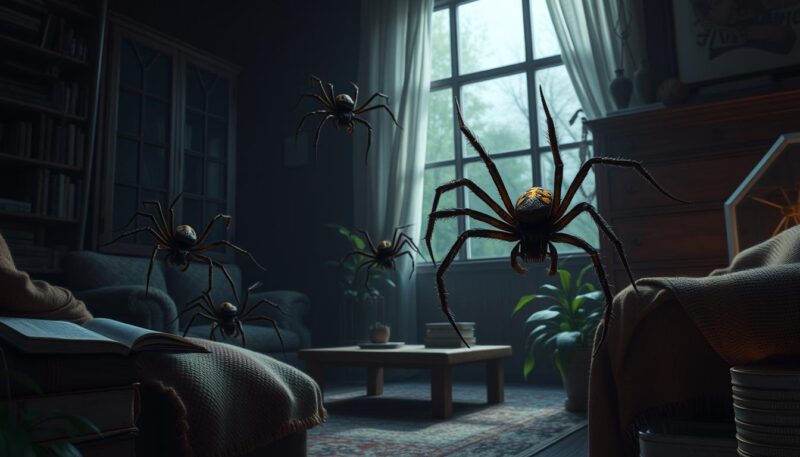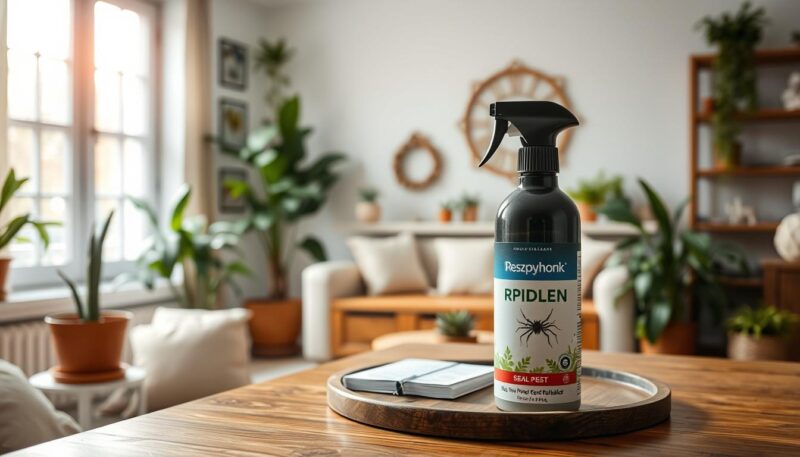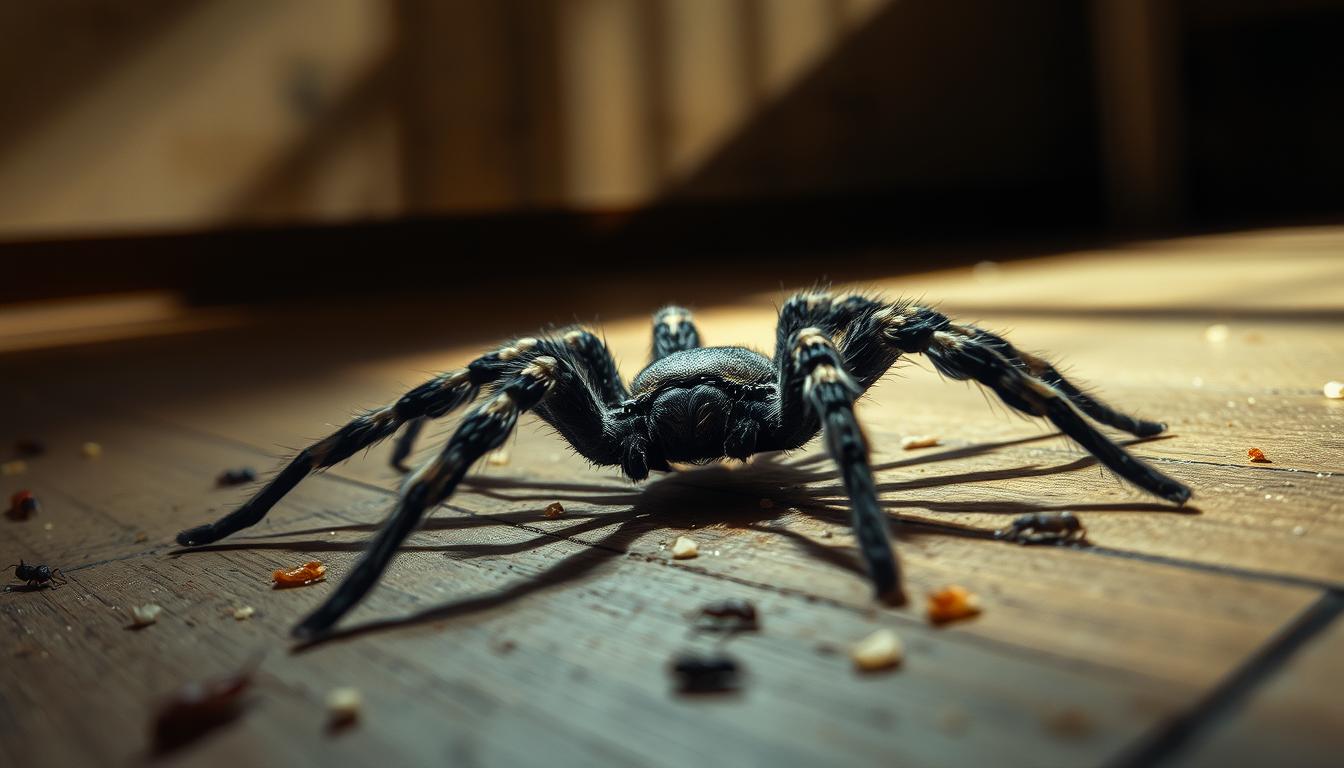It’s not uncommon to see wolf spiders in your home, especially if you live in the United States. These large, hairy arachnids can be quite alarming to encounter. But what exactly attracts these eight-legged creatures to your living space? In this guide, you’ll learn about the common reasons wolf spiders invade homes, as well as safe and effective ways to manage and prevent these pests. Understanding the behavior and motivations of wolf spiders is key to effective pest control. You’ll gain insights into natural repellents and other spider control tips, so you can safeguard your home against these unwelcome visitors.
Key Takeaways
- Learn the common attractions for wolf spiders in homes, such as food sources and ideal living conditions.
- Understand the early signs of a spider infestation and how to identify wolf spiders.
- Discover effective methods for safe spider removal, ensuring both you and the spiders remain unharmed.
- Explore natural repellents and house cleaning tips to prevent future invasions.
- Gain insight into the use of essential oils and plants that act as spider deterrents.
Introduction to Wolf Spiders
Understanding wolf spiders begins by recognizing their unique characteristics and their role in the ecosystem. These arachnids are solitary hunters and are often misunderstood due to their fierce appearance and agile movements. Familiarizing yourself with wolf spider behavior can help demystify these remarkable creatures.
Understanding Wolf Spiders
Wolf spiders are known for their distinct hunting strategies, opting to chase down their prey instead of spinning webs. Their keen eyesight, provided by their eight eyes arranged in three rows, allows them to detect the slightest movements. Insect behavior plays a crucial role in the survival of wolf spiders, as they primarily feed on smaller household spiders and insects.
These spiders thrive in various spider habitats, from woodlands to urban households. Their adaptability makes it essential to understand their behaviors—even within indoor settings. They are often mistaken for other household spiders due to their brownish-gray coloring and robust build.
The Importance of Identifying Wolf Spiders
Identifying wolf spiders is crucial because it helps you differentiate them from potentially harmful arachnids. Wolf spiders are often harmless to humans and can even control pest populations. Being able to identify these spiders accurately involves looking at their size, which generally ranges from half an inch to over one inch, and their eye arrangement.
By identifying and understanding wolf spiders, you can better navigate their presence in your home and take appropriate actions when necessary. Knowledge about these spiders allows you to appreciate their role in the ecosystem, thereby promoting a more balanced approach to managing spider habitats within your household.
| Characteristics | Wolf Spiders | Other Household Spiders |
|---|---|---|
| Size | Up to 1 inch | Varies; often smaller |
| Eye Arrangement | Three rows of eight eyes | Different patterns |
| Hunting Style | Chase prey | Trap in webs |
| Common Habitats | Woodlands, urban areas | Indoor corners, basements |
What Attracts Wolf Spiders in the House?
Your home can inadvertently become a haven for wolf spiders. Their presence often hinges on the availability of food, suitable shelter, and conducive environmental conditions.
Common Reasons for Wolf Spider Invasions
The most frequent attractant for wolf spiders in the house is the abundance of their prey, which includes insects and other small pests. Additionally, unwitting entry points, such as cracks and gaps around windows and doors, provide ample opportunities for these spiders to invade. Climate changes also drive wolf spiders indoors, especially during colder months or heavy rains.
Mating behaviors further contribute, as males venture indoors in search of females during breeding seasons. Consequently, if your home provides ample food sources and maintains an environment that mirrors their outdoor habitat, it becomes an attractive refuge for these eight-legged invaders.
Ideal Conditions for Wolf Spiders
Understanding the conditions that make your home appealing to wolf spiders is key to enhancing spider prevention strategies. These creatures thrive in dark, secluded areas where they can easily hide and hunt. Basements, attics, and cluttered storage spaces offer ideal spider conditions. Moisture also plays a significant role, as wolf spiders prefer damp and cool environments, making bathrooms, kitchens, and laundry rooms prime locations.
An insight into the spaces that foster wolf spiders in the house can help in predicting and mitigating potential infestations. Maintaining a clean, dry, and clutter-free home environment is essential in disrupting the ideal spider conditions and promoting effective spider prevention.

Here is a breakdown of the environments and elements that typically attract wolf spiders:
| Factor | Details |
|---|---|
| Food Availability | Prey such as insects and other small pests |
| Shelter | Dark, secluded areas like basements and attics |
| Climate Changes | Seek refuge indoors during colder months or heavy rains |
| Mating Behaviors | Males enter homes searching for females during breeding season |
| Environmental Conditions | Prefer damp, cool environments in bathrooms, kitchens, and laundry rooms |
Recognizing Signs of a Spider Infestation
Understanding how to detect a spider infestation in your home is crucial for early intervention and effective management. By recognizing the early warning signs and visual indicators, you can take swift action to mitigate the situation before it escalates.
Early Warning Signs
One of the first early warning signs of a spider infestation is an increase in the number of spiders you see around your home. These sightings are often more than just random encounters and can indicate a growing colony. Another indicator is spider webs, which may appear in corners, basements, or other less frequented areas. Pay attention to silk-lined retreats that suggest a comfortable habitat for these arachnids.
Visual Indicators of Presence
Beyond the obvious webs, several visual indicators can reveal the presence of a spider infestation. Look for remains of prey, such as insect carcasses, which spiders often leave behind. You’ll also notice an increase in insect activity as these creatures attract predatory spiders. Regular inspections of your living spaces can help identify these telltale signs early.
By being vigilant and informed, you can spot a spider infestation early on and take necessary steps to address it, ensuring a safer and more comfortable home environment.
Preventing Wolf Spider Infestations
In your quest for a spider-free home, the focus should be on preventive measures that ensure these eight-legged intruders stay out. Proactive steps for preventing spider infestations are vital to maintain a comfortable and safe living space.
House Cleanliness
House cleanliness is the cornerstone of effective pest management. Regular cleaning tasks such as vacuuming, dusting, and sweeping help in removing spider webs, egg sacs, and potential prey for wolf spiders. Clutter provides hiding spots for spiders and their prey, so make it a habit to declutter frequently. By minimizing clutter, you create an environment that is less appealing to spiders, effectively working towards preventing spider infestations.
Equally important is sealing potential entry points. Ensure that windows, doors, and vents are properly sealed. Gaps in walls or foundations should be filled with caulk or weatherstripping to block any possible entry for spiders.
Effective Spider Deterrents
Implementing effective spider deterrents can further decrease the likelihood of a wolf spider invasion. Some common deterrents include:
- Natural oils like peppermint and eucalyptus, which spiders find repulsive.
- Using sticky traps and spider catchers to capture wandering spiders.
- Outdoor lighting management to reduce insect prey that might attract spiders.
Proper pest management involves maintaining your lawn and garden to avoid attracting insects that serve as food for spiders. Keeping the perimeter of your home clear of leaves, mulch, and debris can also help in reducing the likelihood of spiders taking up residence near your home.

| Preventive Measure | Description | Effectiveness |
|---|---|---|
| Regular Cleaning | Vacuuming, dusting, and decluttering | High |
| Sealing Entry Points | Caulking gaps in walls and windows | High |
| Natural Oils | Using peppermint or eucalyptus oils | Medium |
| Outdoor Lighting Management | Reducing lights that attract insects | Medium |
| Yard Maintenance | Keeping the perimeter clear of debris | High |
Natural Repellents for Wolf Spiders
Finding wolf spiders in your home can be unsettling, but resorting to chemical pest control isn’t the only solution. There are numerous natural repellents for spiders that are both effective and eco-friendly. By integrating certain essential oils and home remedies into your routine, you can create an environment that discourages these unwelcome visitors. Additionally, strategically placed plants that repel spiders can serve as a beautiful and natural barrier.
Essential Oils and Other Home Remedies
Essential oils are a popular choice for those seeking natural repellents for spiders. Peppermint oil, for instance, is known for its potent scent which is disliked by many insects, including wolf spiders. Simply mix a few drops with water in a spray bottle and apply it to potential entry points. Eucalyptus oil is another excellent option; not only does it repel spiders, but it also leaves your home smelling fresh and clean. Other home remedies include using vinegar and lemon-based cleaners which can deter spiders while keeping your home spotless.
Plants That Repel Spiders
Incorporating plants that repel spiders into your home decor or garden is both a practical and aesthetically pleasing strategy. Lavender, for example, has a fragrance that many pests find unbearable. Placing lavender pots near windows and entrances can help keep spiders at bay. Another effective plant is the peppermint plant, which releases a strong aroma that spiders tend to avoid. By using natural repellents for spiders, such as strategically placed plants, you can maintain a spider-free home in an eco-friendly way.

